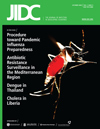Phenotypic and genotypic analysis of clinical isolates Salmonella serovar Typhimurium in western Kenya
DOI:
https://doi.org/10.3855/jidc.610Keywords:
Salmonella, PFGE, antibiotic resistance, VNTR, phage typing, strainsAbstract
Background: Salmonella spp. are recognized as some of the most common causes of enteritis worldwide. This study aimed to identify clinically isolated S. Typhimurium in western Kenya and to assess antimicrobial resistance profiles and strain inter-relatedness.
Methods: The study was performed in rural Maseno, Nyanza province in Kenya, between February 2004 and June 2005. Sixty-three patients with diarrhoea and fever were recruited. S. Typhimurium isolates were confirmed using serotyping, biochemical testing, and 16S rRNA sequencing. Susceptibility to 20 antimicrobials was determined and specific resistance genes were identified by polymerase chain reaction (PCR). Strain diversity was further analyzed using pulsed-field gel electrophoresis (PFGE), fluorescence amplified fragment length polymorphism (fAFLP), and multi-locus-variable-number-tandem regions (MLVNTR).
Results: Twenty S. Typhimurium strains were isolated in the course of the study and their identity was confirmed by 16S rRNA gene sequencing. All 20 S. Typhimurium strains were resistant to ampicillin, streptomycin and sulfamethoxazole; ciprofloxacin resistance and phage DT104 were not detected. PFGE, plasmid profiling, and analysis of selected VNTR loci revealed further heterogeneity among the strains in the study.
Conclusion: S. Typhimurium was commonly isolated from patients with diarrhoea and fever in Maseno. Considerable phenotypic and genotypic diversity was observed among isolates, suggesting that strains belonging to multiple lineages are responsible for disease in the study region. Multiple resistance was common and mediated by a variety of resistance genes but not by phage DT104.
Downloads
How to Cite
Issue
Section
License
Authors who publish with this journal agree to the following terms:
- Authors retain copyright and grant the journal right of first publication with the work simultaneously licensed under a Creative Commons Attribution License that allows others to share the work with an acknowledgement of the work's authorship and initial publication in this journal.
- Authors are able to enter into separate, additional contractual arrangements for the non-exclusive distribution of the journal's published version of the work (e.g., post it to an institutional repository or publish it in a book), with an acknowledgement of its initial publication in this journal.
- Authors are permitted and encouraged to post their work online (e.g., in institutional repositories or on their website) prior to and during the submission process, as it can lead to productive exchanges, as well as earlier and greater citation of published work (See The Effect of Open Access).








